Will Pfeifer's Blog, page 41
June 28, 2012
From the bookshelves: 'California Crazy & Beyond'
In yet another effort to get some content on this blog (I mean, I love Will Elder, but the poor guy can't carry this thing alone), I'm going to talk about some of the many* books I own, picking one basically at random and writing up a few paragraphs. Consider all of these entries recommendations for reading. In this age of words on screens, there's still nothing I love more than an actual, honest-to-goodness book.
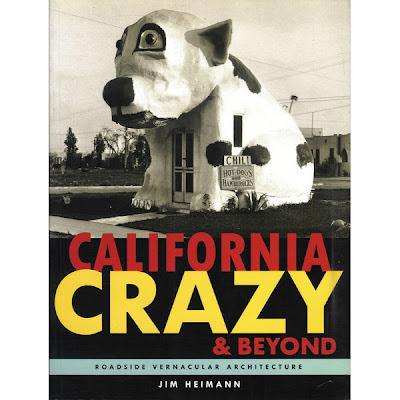
"California Crazy & Beyond" is one of several books Jim Heimann has written about pop culture, history, architecture, you name it. Subtitled "Roadside Vernacular Architecture," it's a loose history of the architectural movement wherein a building would look like the thing it was selling or, failing that, just look like something interesting, something other than just a mere building. The classic example would be the Tail o' the Pup in (where else?) Los Angeles, a hot dog stand shaped like (what else?) a giant hot dog.
But that's only the very beginning of Heimann's fun, fascinating architectural tour. He covers buildings of all shapes and sizes, from those resembling animals and birds to those built like airplanes and hats. There's even a glimpse of Coon's Chicken Inn, an unnerving bit of 1920s racism mentioned in the movie "Ghost World." And this is no dry, dusty history -- it's a book packed with hundreds and hundreds of pictures, offering a glimpse of a past that was so much more visually interesting than our chain-choked present. Heimann's commentary is lively and informative, and he seems to be having a ton of fun with the subject. In the back of the book, he even shares a photo he took of the legendary Oscar Meyer Weinermobile driving past Los Angeles' legendary Randy's Donuts. Now that's an historical pop culture moment.
"California Crazy & Beyond" is available here. I'd guide you to the Book Nook, the store where I got my copy back in 2001, but alas, it's gone out of business.
Next up: A cinematic tour of Times Square, back when it was worth touring.
* many, many, many, many. Really, you have no idea.

"California Crazy & Beyond" is one of several books Jim Heimann has written about pop culture, history, architecture, you name it. Subtitled "Roadside Vernacular Architecture," it's a loose history of the architectural movement wherein a building would look like the thing it was selling or, failing that, just look like something interesting, something other than just a mere building. The classic example would be the Tail o' the Pup in (where else?) Los Angeles, a hot dog stand shaped like (what else?) a giant hot dog.
But that's only the very beginning of Heimann's fun, fascinating architectural tour. He covers buildings of all shapes and sizes, from those resembling animals and birds to those built like airplanes and hats. There's even a glimpse of Coon's Chicken Inn, an unnerving bit of 1920s racism mentioned in the movie "Ghost World." And this is no dry, dusty history -- it's a book packed with hundreds and hundreds of pictures, offering a glimpse of a past that was so much more visually interesting than our chain-choked present. Heimann's commentary is lively and informative, and he seems to be having a ton of fun with the subject. In the back of the book, he even shares a photo he took of the legendary Oscar Meyer Weinermobile driving past Los Angeles' legendary Randy's Donuts. Now that's an historical pop culture moment.
"California Crazy & Beyond" is available here. I'd guide you to the Book Nook, the store where I got my copy back in 2001, but alas, it's gone out of business.
Next up: A cinematic tour of Times Square, back when it was worth touring.
* many, many, many, many. Really, you have no idea.
Published on June 28, 2012 18:36
June 24, 2012
Will Elder Weekends: Mary Worthless!
Besides his legendary EC work for Harvey Kurtzman's Mad, Will Elder also drew plenty of satires for Mad's satirical sister publication, Al Feldstein's Panic. The stories never had the razor-sharp edge that Kurtzman's Mad scripts did, but they did give Elder a chance to prove his uncanny mimicry skills over and over again, spoofing "Dick Tracy," "Skippy" and other beloved comic strips. Here's a panel from "Mary Worthless" in Panic 11 (Oct.-Nov. 1955), where Elder manages to make the art suitably boring and surprisingly funny (and beautifully textured) all at the same time.
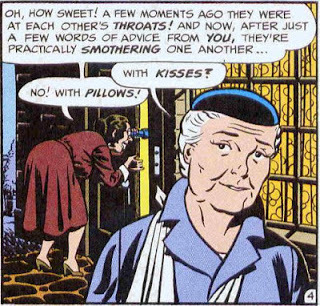
It's nice to know that, more than 50 years after his panel was published, the real Mary Worth is just as boring as ever.
This panel, incidentally, is from the Easily Mused blog. Click on the link and you can read the entire "Mary Worthless" story.

It's nice to know that, more than 50 years after his panel was published, the real Mary Worth is just as boring as ever.
This panel, incidentally, is from the Easily Mused blog. Click on the link and you can read the entire "Mary Worthless" story.
Published on June 24, 2012 07:56
June 17, 2012
Will Elder Weekends: A really big show
Today's post isn't going to be very wordy, but the picture's going to more than make up for it. Here's an illustration of Ed Sullivan from one of the early magazine issues of Mad drawn by Will, and, as usual, he packs more into a single image than most cartoonists pack into an entire career.
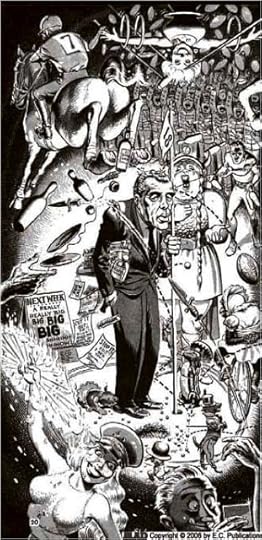


Published on June 17, 2012 08:16
June 11, 2012
A trademark violation of Galactica proportions
While paging through a 32-year-old copy of the zine The Comic Reader (don't ask), I came across this intriguing ad that could only have appeared in the late 1970s, despite the fact that it obviously did appear -- a couple of years past its sell-by date -- in the early 1980s...
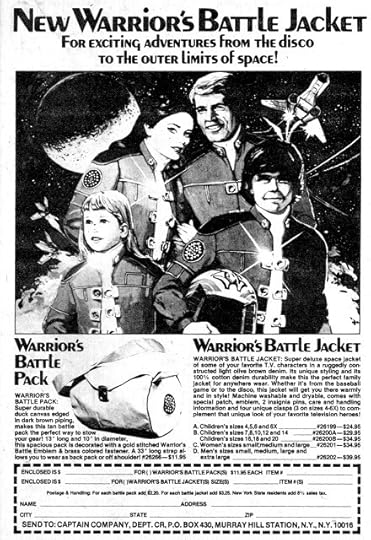 I like how it tries to appeal to four different groups of consumers, while really only aiming at one. You get the family portrait (1), the young TV fans (2), someone who would be enticed by the line mentioning "exciting adventures from the disco" (3) and the unspoken, un-illustrated target audiences -- sci-fi geeks who are reading The Comic Reader (4). Clearly, that's who the fine folks at Captain Company (which was publisher Jim Warren's product arm, right?) were targeting with this ad.
I like how it tries to appeal to four different groups of consumers, while really only aiming at one. You get the family portrait (1), the young TV fans (2), someone who would be enticed by the line mentioning "exciting adventures from the disco" (3) and the unspoken, un-illustrated target audiences -- sci-fi geeks who are reading The Comic Reader (4). Clearly, that's who the fine folks at Captain Company (which was publisher Jim Warren's product arm, right?) were targeting with this ad.
Oddly enough, you know know what's not in this jam-packed advertisement? Any actual use of the words "Battlestar" or "Galactica." They might look like official merchandise, and those might look like the ships from the show in the background, but don't be fooled. After all, these "Battle Jackets" were made for the disco!
 I like how it tries to appeal to four different groups of consumers, while really only aiming at one. You get the family portrait (1), the young TV fans (2), someone who would be enticed by the line mentioning "exciting adventures from the disco" (3) and the unspoken, un-illustrated target audiences -- sci-fi geeks who are reading The Comic Reader (4). Clearly, that's who the fine folks at Captain Company (which was publisher Jim Warren's product arm, right?) were targeting with this ad.
I like how it tries to appeal to four different groups of consumers, while really only aiming at one. You get the family portrait (1), the young TV fans (2), someone who would be enticed by the line mentioning "exciting adventures from the disco" (3) and the unspoken, un-illustrated target audiences -- sci-fi geeks who are reading The Comic Reader (4). Clearly, that's who the fine folks at Captain Company (which was publisher Jim Warren's product arm, right?) were targeting with this ad.Oddly enough, you know know what's not in this jam-packed advertisement? Any actual use of the words "Battlestar" or "Galactica." They might look like official merchandise, and those might look like the ships from the show in the background, but don't be fooled. After all, these "Battle Jackets" were made for the disco!
Published on June 11, 2012 18:33
June 10, 2012
Will Elder Weekends: Beer belongs!
Here's a great ad spoof from the back cover of Mad 27 (April 1956). As with much of Elder's art, it's the amazing realism of the illo that really sells the joke -- everything looks normal and heartwarming until you notice that everyone -- yes, the baby, and yes, the parrot, and yes, even the goldfish -- is enjoying the beer.
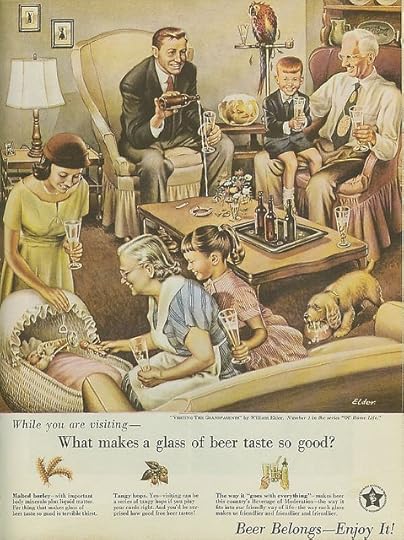


Published on June 10, 2012 16:35
June 8, 2012
You know what you should be reading if you love comic books? 'Bakuman,' that's what
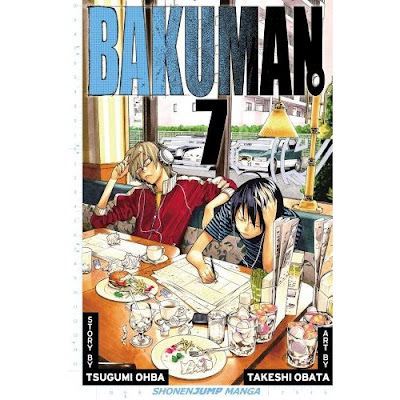 I don't read much manga, but my favorite regularly published comic book these days is, oddly enough, the manga series "Bakuman," which follows the career of Moritaka Mashiro and Akito Takagi, two young creators aspiring to create a hit manga series in modern Japan. (Story by Tsugumi Ohba; art by Takeshi Obata)
I don't read much manga, but my favorite regularly published comic book these days is, oddly enough, the manga series "Bakuman," which follows the career of Moritaka Mashiro and Akito Takagi, two young creators aspiring to create a hit manga series in modern Japan. (Story by Tsugumi Ohba; art by Takeshi Obata)I'm a sucker for any sort of comic about cartooning, but "Bakuman" takes things several steps farther than any American comic I've ever read on the subject, covering not only the creation of the team's various manga series but also the rigid, complex and damn near mystifying rules of the manga system in exhausting but fascinating (to me at least) detail. We see the guys in their studio trying to come up with and improve surefire series concepts, but we spend even more time seeing them meet with editors, compete with rival manga artists and obsess over the popularity ratings that mean success or failure to the series running in Shonen Jump (the manga that the series "Bakuman" originally appeared in).

Plus, "Bakuman" works as an entertaining soap opera, too. There's plenty of cornball romance, with Moritaka vowing not kiss his girlfriend, Miho, until they've both achieved their dreams -- his of being a superstar manga artist and hers of providing the voice for the anime that's based on his theoretically successful manga. And the rest of the cast of characters, from the ever-sweating editors to the crazy collection of other artists and writers, makes "Bakuman" a lot of fun.
There have been 11 volumes so far, with just over 200 pages in each book. I read the entire series will be 20 volumes long, so that's a solid 4,000-plus pages of manga, all devoted to the creation of manga. What's the Japanese word from "meta," anyway?
If my words don't convince you that "Bakuman" is worth your time, maybe this video will. It's from some fans who clearly spent A LOT of time with the series, managing to get the look of the characters -- and not just the two leads -- down perfectly... despite the fact that, in typical cosplay fashion, they're decidedly female. Why can't my comics have fans this dedicated?
Published on June 08, 2012 18:31
June 3, 2012
Will Elder Weekends: Sorry, folks. They can't all be "Starchie!"
Though he was nowhere near as prolific in this area as his former fellow Mad-man Jack Davis, Will Elder did do a few movie posters in the 1970s. None of the movies were classics -- not even close -- but they did give Elder a chance to exercise his talent for drawing celebrity likenesses, even if the celebs in question were decidedly second-tier, as shown in this poster below...
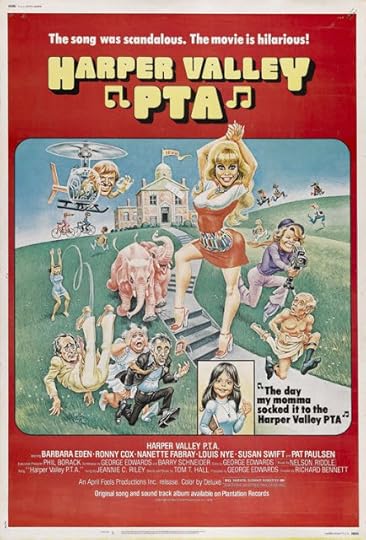


Published on June 03, 2012 12:25
June 1, 2012
Movies I watched in May
Here's the recap of the movies I saw last month. As you may recall, the rules are as follows: I have to watch a movie in full for it to make the list, but I don't have to watch it all at once. So here goes...
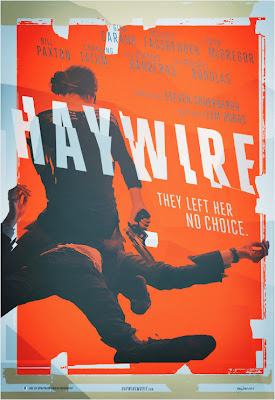
Sharp little action thriller from Steven Soderbergh that's basically a delivery system for the distinctive talents of MMA fighter Gina Carano. Great visuals, nice twisty time scheme and an impressive supporting cast (that includes Ewan McGregor, Michael Douglas and Michael Fassbinder), but like I said, it's all in service of Ms. Carano -- and she's worth the effort.
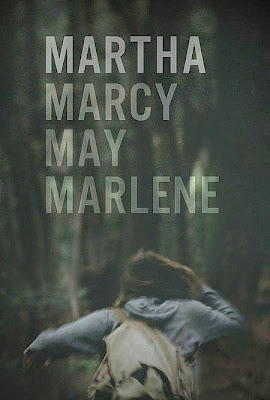
Elizabeth Olsen (the non-twin, talented sister) stars as a former cult member in this slow-burning but effective drama. John Hawkes is suitably (and creepily) understated as the leader. It has one of those non-ending endings that drive some people crazy, but I sort of like 'em -- and I liked this one.
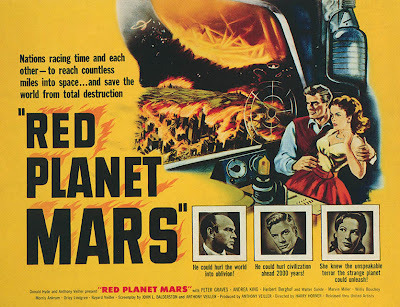
Now this is a crazy little movie, an anti-commie religious parable disguised as a science fiction film without any Martians, spaceships or other sci-fi accoutrements. It does, however, have Peter Graves in square-jaw mode and enough unhinged propaganda to fuel Fox News for a year. I've never seen anything remotely like this one.
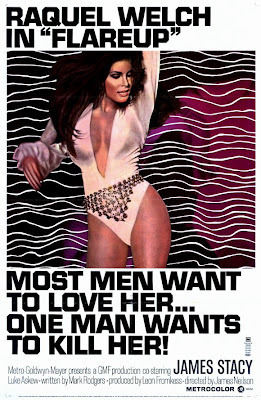
From the fine folks at Warner Archives comes this oddball thriller about a go-go dancer (Raquel, of course) who flees from Las Vegas to L.A. when her friend's crazed ex goes on a rampage. Like most movies from this groovy era, it meanders all over the place, but it's just kitschy enough to be worth watching. That poster image, though? It only counts for a few minutes of film time. Sorry.
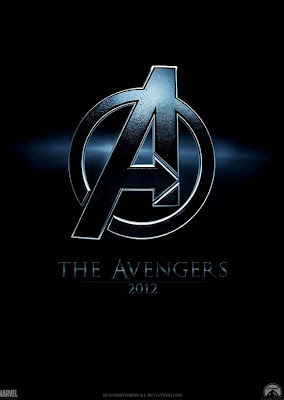
Saw this one with Allie a week or so later (so the crowds had time to die down), and it's just as much fun as everyone says. And yes, the fight scene -- well, sort of -- between the Hulk and Loki is one of the funniest, most crowd-pleasing things I've seen in a long time. (And yes, I donated the cost of my tickets to the Hero Initiative -- and you should, too.)
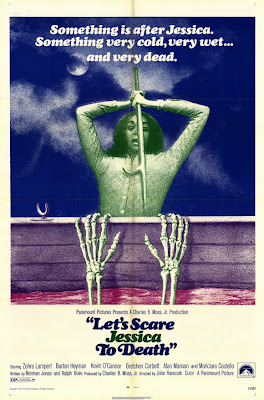
Creepy, low-key little chiller from 1971 that works surprisingly well. No big scares or show-stopping scenes, but there's a sense of gradual dread that builds nicely over the movie's short running time. There's a good reason this one still has a solid rep -- and it's not just the memorable title.
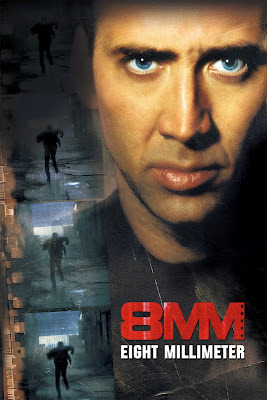
For some reason, I sat down for another viewing of this cheery, jolly laff-riot about the heartwarming world of snuff films. It's undeniably a compelling topic, especially since the screenplay is by Andrew Kevin Walker (the man who wrote "Seven,") but ask yourself how much better this movie might be if director Joel Schumacher hadn't changed the screeplay to suit his own "talents" and "vision" -- or how much better it might be if Schumacher hadn't been allowed withing 500 miles of this movie.
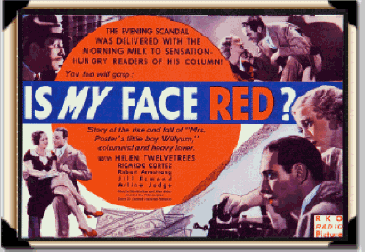
Part of a pre-Code trio from Warner Archives, this newspaper picture stars Ricardo Cortez (Real name? Jacob Krantz!) as a gossip columnist who stumbles onto a speakeasy murder. No great surprises here, but it zips along as only a pre-Code newspaper picture can. Robert Armstrong -- looking surprisingly thin -- plays a rival columnist just a year before he'd sail to Skull Island to capture that big ape.
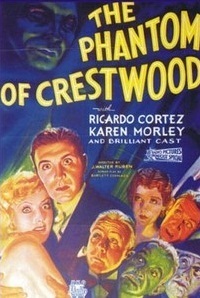
Another Ricardo Cortez feature (how often do you hear that phrase in 2012?) from Warner Archives. This one was apparently part of what passed for a multi-media event in 1932: "The Phantom of Crestwood" (the movie) finished the story that began in "The Phantom of Crestwood" (the radio drama), with audiences forced to pay at the box office to hear how the mystery was solved. Otherwise, it's your standard old dark house thriller, with a surprisingly creepy death mask offering the most memorable moments.
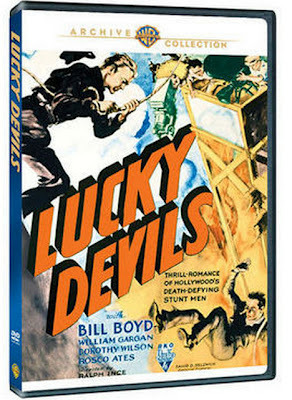
The last movie in the aforementioned Warner Archives trilogy is the most interesting, a wild-and-woolly action pic focusing on a group of devil-may-care stuntment led by Bill Boyd (before he became famous as Hopalong Cassidy). There's not a whole lot of plot, but there are some crazy stunts, all performed by desperate men trying to earn a few bucks in the early days of the Great Depression. Look for Lon Chaney Jr., back when he was still being billed as Creighton Chaney.

Sharp little action thriller from Steven Soderbergh that's basically a delivery system for the distinctive talents of MMA fighter Gina Carano. Great visuals, nice twisty time scheme and an impressive supporting cast (that includes Ewan McGregor, Michael Douglas and Michael Fassbinder), but like I said, it's all in service of Ms. Carano -- and she's worth the effort.

Elizabeth Olsen (the non-twin, talented sister) stars as a former cult member in this slow-burning but effective drama. John Hawkes is suitably (and creepily) understated as the leader. It has one of those non-ending endings that drive some people crazy, but I sort of like 'em -- and I liked this one.

Now this is a crazy little movie, an anti-commie religious parable disguised as a science fiction film without any Martians, spaceships or other sci-fi accoutrements. It does, however, have Peter Graves in square-jaw mode and enough unhinged propaganda to fuel Fox News for a year. I've never seen anything remotely like this one.

From the fine folks at Warner Archives comes this oddball thriller about a go-go dancer (Raquel, of course) who flees from Las Vegas to L.A. when her friend's crazed ex goes on a rampage. Like most movies from this groovy era, it meanders all over the place, but it's just kitschy enough to be worth watching. That poster image, though? It only counts for a few minutes of film time. Sorry.

Saw this one with Allie a week or so later (so the crowds had time to die down), and it's just as much fun as everyone says. And yes, the fight scene -- well, sort of -- between the Hulk and Loki is one of the funniest, most crowd-pleasing things I've seen in a long time. (And yes, I donated the cost of my tickets to the Hero Initiative -- and you should, too.)

Creepy, low-key little chiller from 1971 that works surprisingly well. No big scares or show-stopping scenes, but there's a sense of gradual dread that builds nicely over the movie's short running time. There's a good reason this one still has a solid rep -- and it's not just the memorable title.

For some reason, I sat down for another viewing of this cheery, jolly laff-riot about the heartwarming world of snuff films. It's undeniably a compelling topic, especially since the screenplay is by Andrew Kevin Walker (the man who wrote "Seven,") but ask yourself how much better this movie might be if director Joel Schumacher hadn't changed the screeplay to suit his own "talents" and "vision" -- or how much better it might be if Schumacher hadn't been allowed withing 500 miles of this movie.

Part of a pre-Code trio from Warner Archives, this newspaper picture stars Ricardo Cortez (Real name? Jacob Krantz!) as a gossip columnist who stumbles onto a speakeasy murder. No great surprises here, but it zips along as only a pre-Code newspaper picture can. Robert Armstrong -- looking surprisingly thin -- plays a rival columnist just a year before he'd sail to Skull Island to capture that big ape.

Another Ricardo Cortez feature (how often do you hear that phrase in 2012?) from Warner Archives. This one was apparently part of what passed for a multi-media event in 1932: "The Phantom of Crestwood" (the movie) finished the story that began in "The Phantom of Crestwood" (the radio drama), with audiences forced to pay at the box office to hear how the mystery was solved. Otherwise, it's your standard old dark house thriller, with a surprisingly creepy death mask offering the most memorable moments.

The last movie in the aforementioned Warner Archives trilogy is the most interesting, a wild-and-woolly action pic focusing on a group of devil-may-care stuntment led by Bill Boyd (before he became famous as Hopalong Cassidy). There's not a whole lot of plot, but there are some crazy stunts, all performed by desperate men trying to earn a few bucks in the early days of the Great Depression. Look for Lon Chaney Jr., back when he was still being billed as Creighton Chaney.
Published on June 01, 2012 20:12
May 28, 2012
Will Elder Weekends: Special Memorial Day Edition
I don't think Will ever penciled any stories for Harvey Kurtzman's EC war comics, but he inked plenty of them, with pencils provided by the great (and recently late) John Severin. Here's a panel from TWO-FISTED TALES #26 (1952), an issue that spotlighted the Korean War.
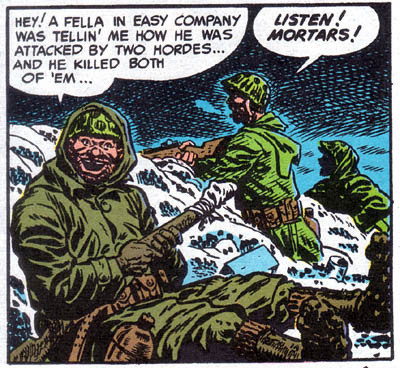
(Image courtesy of Four Realities blog, by the way.)
Elder didn't serve in Korea, of course, but he (and Severin -- and Kurtzman, for that matter) did serve in World War II. He served in the Army in Europe, putting those artistic talents of his to use drawing maps that would be used in the invasion of Normandy.


(Image courtesy of Four Realities blog, by the way.)
Elder didn't serve in Korea, of course, but he (and Severin -- and Kurtzman, for that matter) did serve in World War II. He served in the Army in Europe, putting those artistic talents of his to use drawing maps that would be used in the invasion of Normandy.
Published on May 28, 2012 15:16
May 26, 2012
Nice to see the folks at MAD still remember H.E.R.O....
... and they bring up something I almost forgot. Long before DC and Marvel were planning gay weddings and retconning gay characters into their superhero universes, artists Leonard Kirk, John Van Fleet and I (with the help of editor Peter Tomasi) told a transgender storyline in the pages of H.E.R.O. issues 12, 13 and 14.
Joe, you were truly a pioneer!
Here's the image from the Mad blog...
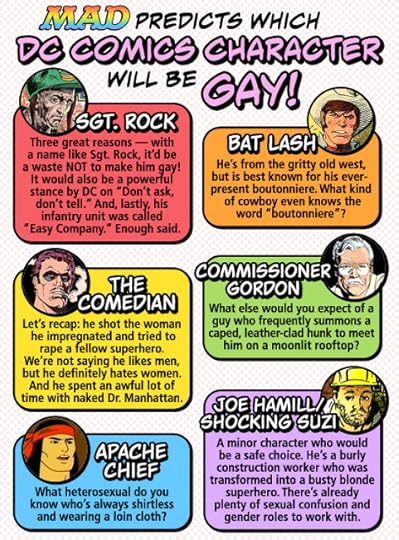
And here's the link. You'll have to click on it to get the final joke those six boxes are building up to, though you really should be able to figure it out yourself.
Special thanks to my old small press compadre J. Kevin Carrier for alerting me to this bit of comedy.
Joe, you were truly a pioneer!
Here's the image from the Mad blog...

And here's the link. You'll have to click on it to get the final joke those six boxes are building up to, though you really should be able to figure it out yourself.
Special thanks to my old small press compadre J. Kevin Carrier for alerting me to this bit of comedy.
Published on May 26, 2012 15:25
Will Pfeifer's Blog
- Will Pfeifer's profile
- 23 followers
Will Pfeifer isn't a Goodreads Author
(yet),
but they
do have a blog,
so here are some recent posts imported from
their feed.



